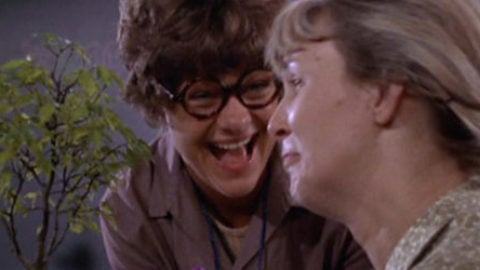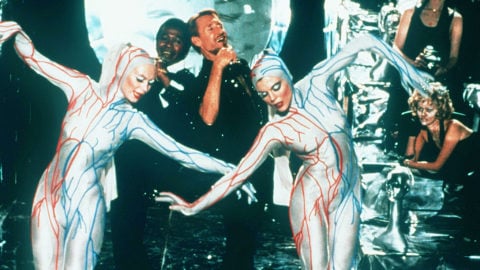Queer & Now & Then: 1932
In this biweekly column, I look back through a century of cinema for traces of queerness, whether in plain sight or under the surface. Read the introductory essay.
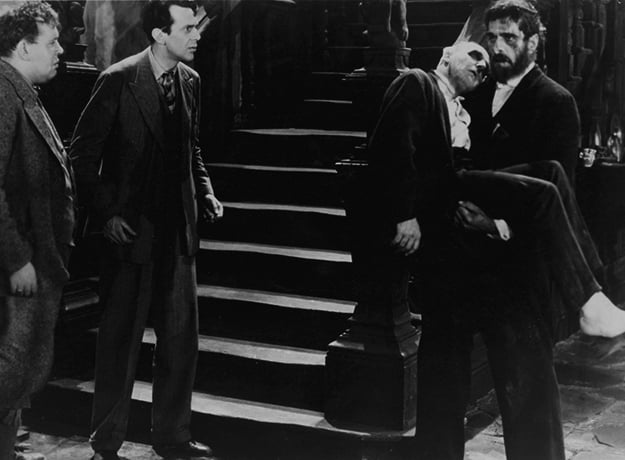
The Old Dark House
Throw a rock in a room full of gays (but please don’t!), and you’re likely to hit a horror movie lover. No discussion of queerness in film is complete without a reckoning with narrative cinema’s most disreputable genre, and the reasons for that are—like so much of queer culture—in some ways covert and in other ways as obvious as a billboard in Ebbing, Missouri. Historically there has been no single mainstream category of film that so consistently menaces the heterosexual lifestyle. More than anything, the villains in these films, monstrous males or fatal females, are interrupters; essentially their most heinous act is to insert themselves between male-female couples, acting as a threat to their bond. This in turn becomes a larger social threat, a tear in the fabric of the status quo. Think of Dracula; of the Phantom of the Opera and the Creature from the Black Lagoon; of Freddy Krueger and Michael Myers; of Fatal Attraction’s Alex Forrest and the domestic troublemakers from The Hand That Rocks the Cradle and Single White Female: all of these scoundrels have an uncanny ability to disrupt ostensibly happy hetero relationships or, particularly in the later slasher films, couples in flagrante delicto.
The climactic vanquishing of these grotesque aberrations allows life to proceed (we are freed, the straights can breed). Yet wasn’t it a little more fun with them around? Hence the central paradox of movie monsters: the horror genre implicitly asks us to identify with them, to see the world a tad askew and to want to cause mayhem and destruction to the more financially, physically, or socially privileged among us. This productively discomfiting form of identification is perhaps more acute for the queer viewer. For gays, relegated to the dustbins for most of cinema’s existence, insidious monsters can be figures of empowerment; they are often more decadent (Phantom of the Opera), worldly (Hannibal Lecter), romantic (Dracula), amusingly catty (Freddy), or bullshit-free (Michael Myers) than the supremely dull protagonists struggling to survive. If there wasn’t a part of us that secretly wanted an all-expenses-paid weekend to the Goth lair of that gay leather icon known to friends as “Pinhead,” then Hellraiser wouldn’t function at all.
There’s no other type of film in which straightness is less compelling, and this was especially true during the seminal horror cycle of the first half of the 1930s. The monsters in these early sound films were constantly toying with far less vivid “heroes,” and, as played by the likes of Bela Lugosi, Boris Karloff, Charles Laughton, and Peter Lorre, they shone brighter, the novelty of their foreign accents making them appealingly continental exotics as much as dastardly threats. During this pre-Code sweet spot—films made before Hollywood’s putrid purifier Joseph Breen ensured movies would adhere to Motion Picture Producers and Distributors of America President Will Hays’s restrictive moral guidelines—their decadence and immorality was often all the more sexually charged, reflective of a rampaging id not yet contained. In such films as Dracula (1931), Dr. Jekyll and Mr. Hyde (1931), The Old Dark House (1932), Island of Lost Souls (1932), and The Black Cat (1934), there’s a sense of fun to the degradation, a free-floating, almost non-gender-specific psychosexual energy. Perhaps the most willfully perverse of these—and definitely the least respectable—is MGM’s The Mask of Fu Manchu (1932), which, despite its harrowingly vile racism, is more than worth a discussion around these topics for the singular, perplexing way it brings its own queerness to the forefront, baldly inviting its spectators to take pleasure in kinky depravity and gleefully conflating horror and desire.
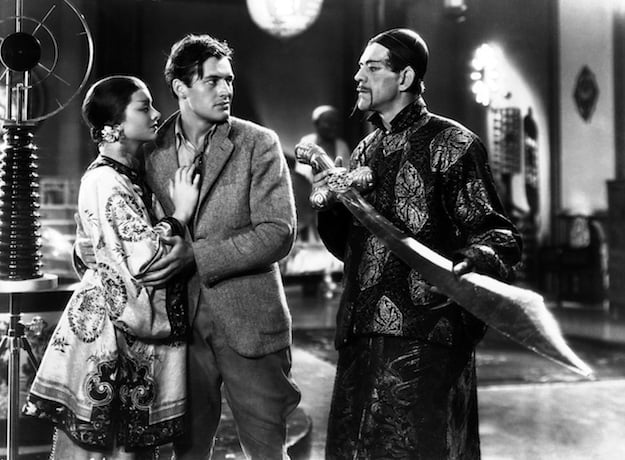
The Mask of Fu Manchu
The very title should raise instant hackles: the name Fu Manchu has long been a kind of shorthand for the complete villainization of the ethnic Other in Western culture. Maybe the most demoralizing fictional figure for assimilated or immigrant Asians in the West, Fu Manchu was the invention of working-class British novelist Sax Rohmer, and he grew equally popular in the U.S. in the first half of the 20th century. The mastermind of elaborate sinister plots to kidnap, torture, or kill white people, with the hoped-for end result of wiping out Western civilization, the long-mustachioed brute was a personification of xenophobia and anti-immigrant scapegoating, an embodiment of the “Yellow Peril” who operates from underground lairs, employs slaves and minions to do his evil bidding, and uses witchcraft and poisons. Beyond serial novelization and movies, the character has turned up in comics, TV, and radio programs, and traces of the Fu Manchu archetype can be found throughout the decades in any number of films that turn a distrustful eye toward Chinese laundries and opium dens, from musicals (Thoroughly Modern Millie) to comedies (Alice) to adventure pastiche (Big Trouble in Little China).
The character’s embodiment by horror icon Boris Karloff in this 1932 iteration, directed by British-born, silent-era stalwart Charles Brabin, is especially bold in its nefarious racism. He’s also perhaps the queerest version: presented as a dandyish, Harvard-educated aesthete, the famously lisping Karloff—the white actor’s eyes taped back in that shockingly prevalent practice dubbed by some as “yellow-face”—delights not only in threatening and enacting terrible violence but also in his own glittering fineries and elegantly manicured long fingernails, not to mention his cadre of muscled Asian and African slave boys, rarely dressed in more than skimpy underwear. The film, a triumph of production design (and of nothing else, really), seems to enjoy indulging in the villain’s whims, making him the cleverest, most appealing character in a film plagued by a cast of drab ninnies and dodgy early-’30s sound recording. Our stupidly intrepid white folk— archaeologists, of course—first encounter him when organizing a hunt for Genghis Khan’s tomb. Fu Manchu doesn’t take kindly to colonialist-minded curators, setting a British Museum ambush (shades of Erik Killmonger?), and he begins to try to destroy them one by one. (For their part, the whites aren’t particularly culturally sensitive to the artifacts— in a passing gesture, Jean Hersholt’s adventurer Von Berg tosses a cigarette butt into an Egyptian urn.)
As it proceeds, The Mask of Fu Manchu reveals itself as less interested in consequential plotting than in finding ways of placing its hapless Caucasians in wildly perilous situations, including, in one alarming scenario, a man tied to a seesaw as he’s slowly lowered into a pit of hungry crocodiles (yes, those are real crocodiles). Of particular interest here is the fact that the character who gets subjected to the most elaborate, explicit, and sexualized tortures is not the main explorer’s fetching daughter Sheila (Karen Morley), but her strapping, dopey, and equally dull husband, Terrence “Terry” Granville. Played by former Dartmouth footballer Charles Starrett, the alarmingly square-jawed 6-foot-2-incher was one of those early sound actors hired for his deep voice as much as his ability to look pretty standing around, a less captivating Charles Farrell. The film’s queered gaze is first revealed when Fu Manchu hands Starrett over to his wicked, nymphomaniac daughter (Myrna Loy, shockingly), who proceeds to have two of her father’s underwear-clad slaves chain him up, rip his shirt off, and whip him, while the young woman looks on with frenzied sexual excitement (“Faster, faster!”). Afterward, she asks, “He is not entirely unhandsome is he, Father?” Daddy’s response: “For a white man, no.”
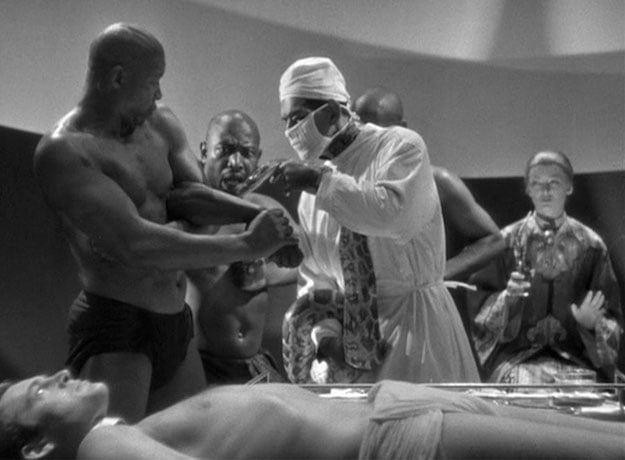
The Mask of Fu Manchu
The homoeroticization becomes truly unambiguous in a later, far more extended scene in which Fu Manchu himself delightedly hovers over the prone body of the man, clad only in loincloth and manacled to a table, and proceeds to drag his nails over his heaving, sweaty chest. The mise-en-scène is lousy with half-naked slaves, while poor Terry receives the not-at-all phallic punishment of being taunted with an enormous snake, from which Fu Manchu extracts a serum that will cause the poor stud to fall completely under the evil man’s control, a willing servant who will follow orders and help Fu Manchu in his noble cause to “wipe out your whole accursed white race!” The historical oddness of this gender-switched sequence doesn’t need to be overstated; just the next year, Fay Wray would be nearly sacrificed to a romantic ape in one of cinema’s most over-analyzed bondage setups.
What makes it particularly intriguing here is the gaze the camera so fully takes on, allowing those viewers so inclined to engage in its particular visual pleasure. Eroticized male semi-nudity was certainly not unheard of in this decade—Joel McCrea and Clark Gable were famous for flaunting their physiques—and in the silent era Ramon Novarro and especially Rudolph Valentino were worshipped for their mix of feminine beauty and heroic masculinity; the latter would often find himself in similarly sadomasochistic scenarios, all the better to put his attributes on display. But for viewers to be invited to enjoy themselves through the eyes of a doubled Other (Asian and queer) remains even more shocking than the film’s gory, pre-Code tortures. Such a sequence naturally makes one wonder how much can be traced back to intentionality. But there’s nothing much given in the way of explanation besides the fact that one of the screenwriters was Edgar Allan Woolf, who, apart from being perfectly named, was an open homosexual in the boys club of 1930s Hollywood, destined to be one of the credited writers of The Wizard of Oz.
As should be clear from above, there is nothing remotely surreptitious to a gay reading of this film, which makes it something of an anomaly for the era. The pinkish content is evident enough that when the Japanese-American Citizens League boycotted the film’s 1972 re-release and demanded (unsuccessfully) that MGM pull the film from its catalog, part of their official statement cataloguing the film’s sins said: “Fu Manchu is an ugly evil homosexual with five-inch fingernails while his daughter is a sadistic sex fiend.” The film had in fact been met with controversy even from the beginning, including a formal protest from the Chinese Consulate in Los Angeles, and contemporary reviews treated it as the work of sheer indecency that it is. (Almost impossibly, the end of the film manages a punch line that in its smarmy jokiness is even more culturally offensive than anything that came before.) The monstrousness of the racism in the Fu Manchu universe is well discussed and documented, but The Mask of Fu Manchu’s treatment of its own specific, “depraved” sensuality is provocative, producing a split identity in the viewer. The film invites us to experience fear and disgust for its queer monster, but lets us partake of his fleshly appetites.
Michael Koresky is the Director of Editorial and Creative Strategy at Film Society of Lincoln Center; the co-founder and co-editor of Reverse Shot; a frequent contributor to the Criterion Collection; and the author of the book Terence Davies, published by University of Illinois Press.



